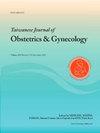冷尖射频消融用于复杂单绒毛膜双胞胎选择性胎儿复位的新技术
IF 2
4区 医学
Q2 OBSTETRICS & GYNECOLOGY
引用次数: 0
摘要
目的建立一种采用冷尖射频消融(RFA)对单绒毛膜(MC)双胞胎进行选择性胎位减少的新方法,并分析其围产儿结局。材料与方法纳入2020 - 2024年双胎输血综合征(TTTS)、选择性胎儿生长受限(sFGR)和双胎动脉反向灌注序列(TRAP)的复杂MC双胞胎。由于预期预后不良,所有病例均提示选择性胎儿复位。等边三角法采用17G冷尖射频消融术单穿刺4次消融脐带止点、脐静脉及脐双动脉,完全阻断血流。功率从60w、80w、80w、100w开始,每个站点1分钟。对结果进行分析。结果在同一医疗中心共收集治疗51例。将前20例患者分为传统单点消融组和新型4点消融组。在整个系列中,RFA手术后的总双胎生存率为88%(51例中有45例)。然而,新型4点组的双胎生存率优于单点组(93.5% vs 80%),差异有统计学意义。两组产妇年龄、胎龄、手术时间、早产率无统计学差异。结论采用等边三角止血法止血,成功率高,无产妇并发症。17g冷尖RFA在低温下工作,以避免热损伤。这可能是单绒毛膜妊娠RFA的新选择。本文章由计算机程序翻译,如有差异,请以英文原文为准。
A novel technique with cool-tip radiofrequency ablation for selective fetal reduction in complicated monochorionic twin
Objective
To invent a novel method for selective fetal reduction in monochorionic (MC) twin using cool-tip radiofrequency ablation (RFA) and analysis the perinatal outcome.
Material and methods
Complicated MC twins including twin-to twin transfusion syndrome (TTTS), selective fetal growth restriction (sFGR) and twin reverse arterial perfusion sequence (TRAP) were enrolled from 2020 to 2024. All cases were indicated for selective fetal reduction due to expected poor outcome. Equilateral triangle method using single puncture 4 times ablation with 17G cool-tip RFA to cord insertion site, umbilical vein and two umbilical arteries for complete stopping the blood flow. The power was starting from 60 W, 80 W, 80 W and 100 W 1 min each site. Outcome were analyzed.
Results
A total of 51 cases were collected and treated in a single medical center. We divided first 20 cases as tradition group using single point ablation and novel 4-point ablation group after 21st cases. The overall co-twin survival rate after RFA procedure was 88 % (45 out of 51) in whole series. However, the co-twin survival rate in the novel 4-point group was better than single point group (93.5 % vs 80 %) with statistically significance. The maternal age, procedure at gestational age, procedure time and preterm birth rate did not show statistically difference between two groups.
Conclusions
This novel equilateral triangle method to stop all the umbilical blood flow achieved the high successful rate without maternal complication. The 17 g cool-tip RFA worked at low temperature to avoid thermal damage. This might be the new choice of RFA in monochorionic pregnancies.
求助全文
通过发布文献求助,成功后即可免费获取论文全文。
去求助
来源期刊

Taiwanese Journal of Obstetrics & Gynecology
OBSTETRICS & GYNECOLOGY-
CiteScore
3.60
自引率
23.80%
发文量
207
审稿时长
4-8 weeks
期刊介绍:
Taiwanese Journal of Obstetrics and Gynecology is a peer-reviewed journal and open access publishing editorials, reviews, original articles, short communications, case reports, research letters, correspondence and letters to the editor in the field of obstetrics and gynecology.
The aims of the journal are to:
1.Publish cutting-edge, innovative and topical research that addresses screening, diagnosis, management and care in women''s health
2.Deliver evidence-based information
3.Promote the sharing of clinical experience
4.Address women-related health promotion
The journal provides comprehensive coverage of topics in obstetrics & gynecology and women''s health including maternal-fetal medicine, reproductive endocrinology/infertility, and gynecologic oncology. Taiwan Association of Obstetrics and Gynecology.
 求助内容:
求助内容: 应助结果提醒方式:
应助结果提醒方式:


